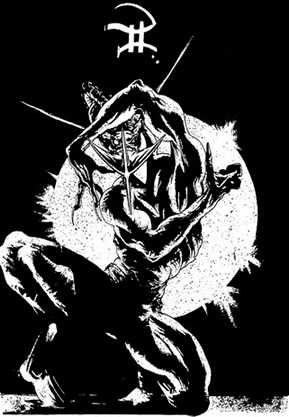
I’ve recently been re-reading Nemesis the Warlock. This was an 80s comic strip serialised in British weekly anthology 2000AD. I was amazed at how well this held up, particularly when compared to contemporary American comics.
Nemesis is set thousands of years in the future. Earth, now renamed Termight, has been hollowed out to form a massive city which includes huge gravity-defying roadways. The Terran Empire is ruled by Torquemada, an reincarnation of the 15th century Spanish priest who led the Spanish Inquisition. This modern Torquemada leads a genocidal campaign of extermination against both his own people (including dream scanners – ‘Sleep is no refuge for impure thoughts’) and against the galaxy’s aliens. An alien resistance movement called Credo is fighting back, led by a powerful warlock called Nemesis. The saga focusses on the struggle between the two.
Comedy is an important part of this story. Fascism is repeatedly mocked, with bigotry portrayed as, not simply evil, but ridiculous. There are the slogans (‘Be pure, be vigilant, behave’ turned up on the Holy Bible album) and ridiculous hypocrisy. One double-page spread features a Torquemada convention, mocking the sort of events held in the comics industry., where the dictator’s ‘fans’ buy expensive tat.
The early books, illustrated by Kevin O’Neill and Bryan Talbot, are incredibly detailed. Kevin O’Neill, the first artist, was actually once banned by the comics code authority for his very style. There are also photo stories by Brighton’s Tony Luke, but my favourite artist on the character is John Hicklenton. He worked on the two ‘historical’ books, one set in the Inquisition, and one set in the Thatcher period. The very figures of the characters here are twisted and grotesque, Torquemada’s body seeming to be bursting from its skin.
I read Nemesis for the first time when book 7 was originally published. This one featured Torquemada travelling back in time to meet his ancestor during the Spanish Inquisition. I was 11 years old at the time, and the comic is strong stuff. Setting a science fiction comic during such an ugly period of history is strange but works to great effect.
Book 9 was set in (at the time) contemporary London. Torquemada has been sent back through a time accident, and has set himself up as chief of police. At the same time, he takes advantage of people displaced from ‘time accidents’ as a slum landlord. It should be a disaster, but it worked – even the section where Torquemada was obsessed by one of his tenants, a Goth student.
For me, the most shocking thing about Nemesis was how well it had had aged, with the satire hitting as hard as it did at the time. The oppressive Britain in Book 9 is probably slightly less of an exaggeration than it was at the time, when the home office send squads to capture illegal immigrants. It would be easy to fit a Farage or a Johnson among the characters of the Terran empire.
Few artists working in contemporary superhero comics are creating such detailed work (although the pace was brutal for the original artists). The book’s complexity probably stands against it being a classic and it never worked in the US editions, where is was shrunk and recoloured. I don’t think there would be much culture I enjoyed at 11 which would impress me as much as Nemesis has decades later.